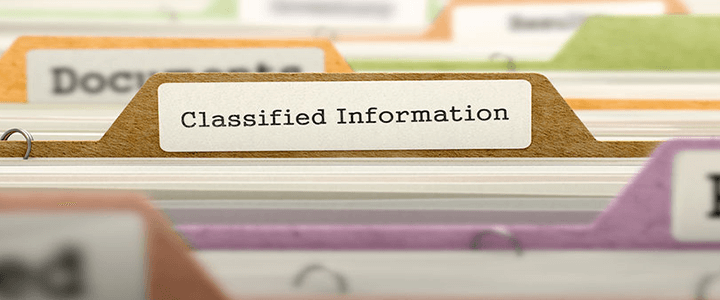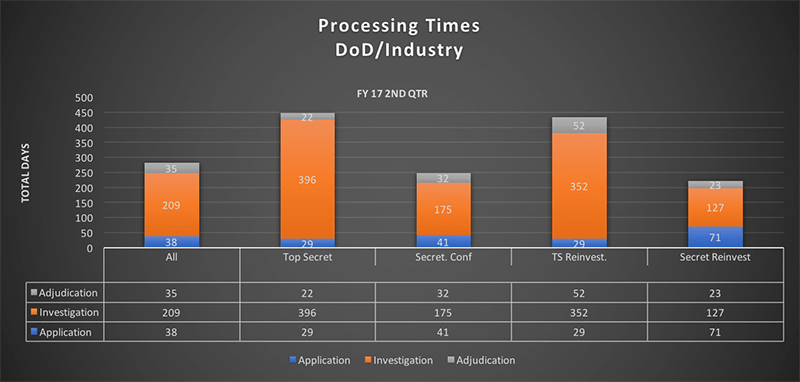What are the current clearance processing times for the Department of Defense (DoD) and associated industries (including defense contractors) falling under its purview?
Under the 2004 Intelligence Reform and Terrorism Prevention Act (IRTPA), the timeline for processing the initial Top Secret and Secret security clearance applications at the federal level was on average 60 days, with another 10 to 12 days for submission. At that time, the actual number of days creating the average ranged from 30 to 180 days. The remaining 10% of the applications took from 6 months to a year.
While most federal agencies, and especially the Office of Personnel Management (OPM) that process 95% of all background investigations for civilian, military and contract employment, were meeting the target deadlines by 2010, it didn’t last long. National security leaks and issues with contract investigations starting in 2013 extended total processing times, thus causing a backlog that continued to snowball and one that exists even yet today.
As an example, in the chart below are the processing times for the DoD’s FY 17 2nd Quarter by security clearance level for the three steps: application, investigation and adjudication, along with reinvestigations.
Data courtesy of National Background Investigations Bureau
As the data shows, application and adjudication times remain fairly constant and are only a small part of the overall days it takes to complete a request. It is the investigation portion that takes the longest. This portion is manpower and time intensive due to the interview process. Throw in Zero Deficit where an agency can’t spend more than they are allocated by Congress, and the answer isn’t as simple as hiring more investigators.
Missing or inaccurate application information can further delay processing as the process stops until issues are resolved. And because OPM operates on a fee-for-service basis to do the background investigations, the requesting agency might not have the money in its limited budget to pay for all of the investigations it would like done in a fiscal year.
DoD Reinvestigations
Once a security clearance has been issued, it must be reinvestigated periodically, with actual time depending on the level of clearance, to 1) see if anything in that person’s background since the issuance or last reinvestigation would preclude them from keeping their clearance or 2) if the position they hold even needs a clearance any longer. As the chart shows, reinvestigations take almost as long as initial clearances at the respective levels.
The numbers
The number of days it takes to approve requests are staggering. With a current goal of 114 days total start-to-finish for initial Top Secret applications, the breakdown of the goal is:
- 14 days for the application
- 80 days for investigation
- 20 days for adjudication
… but the processing time as of March 2017 for the fastest 90% of these applications was 458 days.
Secret/Confidential had a goal of 74 days, but took on average 272 days for processing.
As far as number of adjudications processed during FY 2017 2nd Quarter for the DoD:
- 13,209 – Initial
- 2,564 – Top Secret
- 10,645 – Secret/Confidential
- 6,054 – Top Secret Reinvestigations
- 6,216 – Secret Reinvestigations
These numbers are only a blip on the radar screen with around 500,000 investigations/reinvestigations in the backlog as of early 2016.
Effects of dod security clearance Delay
If an individual’s job requires a security clearance, that person cannot access classified information until a clearance at the level of information being handled is issued. As noted in the chart, that can take as long as 250 days at the Secret level.
And to add to the absurdity of it all, work the government considers essential goes unperformed due to a lack of security clearances for personnel that are supposed to be doing that work; add to it that contractors can even be penalized for contractual non-performance of work by the very agencies that are holding up the clearances!
Industries falling under the DoD can request an interim clearance for new hires. In most cases this clearance can be issued in a little over a month, provided there is not something in the individual’s National Agency Check (NAC) that would hold up the interim issuance.
As of July 2016, an Interim can no longer be issued based just on the e-QIP (electronic Questionnaires for Investigations Processing) web-based questionnaire or PDF-fillable SF86 (Questionnaire for National Security positions) alone. Now the NAC must also be done before an interim can be issued.
In the case of former military members who have been out less than 24 months, and their clearance is not due for reinvestigation, a clearance (at the same level as they had) can be reinstated fairly quickly; the quickness of clearance reinstatement means enabling the person to actually do the work they were hired to do sooner, saving the company time and money.
At a recent meeting, the Deputy Assistant Director for the National Background Investigation Bureau (NBIB) said “by the end of the year (2017) the NBIB will have hired approximately 580 new investigators (civil servant and contractors), contracted to four companies performing investigations, and has implemented more aggressive oversight of contractor performance.”
Will this drop the backlog? Only time will tell.




